Nokia 4A0-C01 Nokia NRS II Composite Exam Exam Practice Test
Nokia NRS II Composite Exam Questions and Answers
Click on the exhibit.
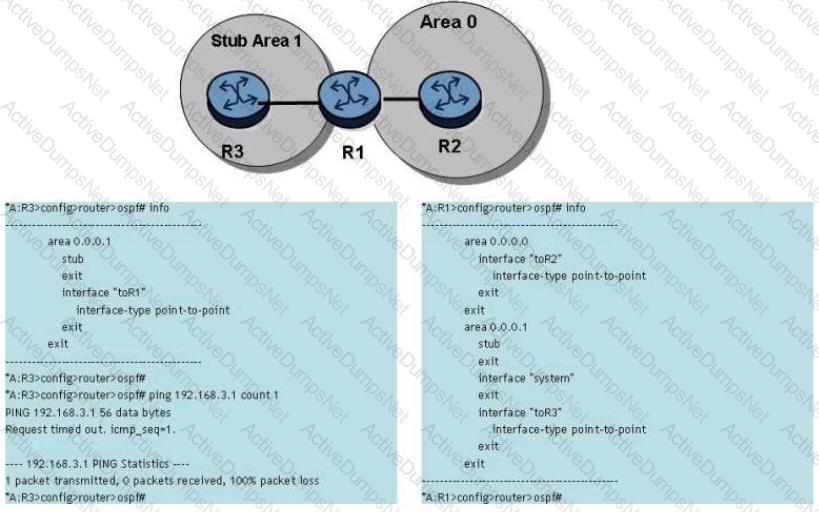
192.168.3.1 is a loopback interface on router R2 and is distributed to OSPF area 0, but the ping fails from router R3. Which of the following is a possible solution to the problem?
Which of the following statements regarding the last two octets of the LDP identifier is true?
Click on the exhibit.
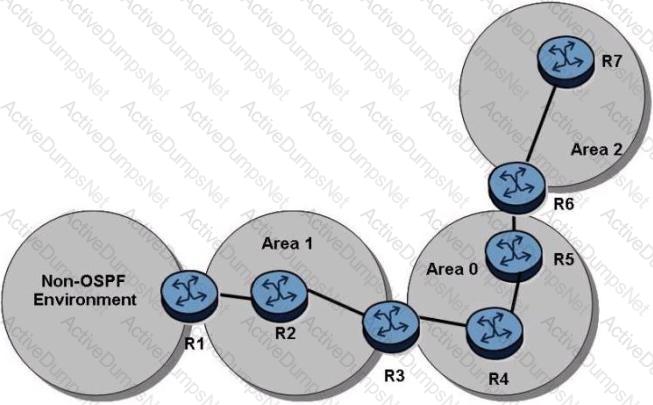
In the topology shown, router R1 is an ASBR configured to export external routes to OSPF. Assuming that there are no stub networks, which of the following statements regarding Type 5 LSA generation is TRUE?
Which of the following timers can be adjusted to reduce the time a router waits between attempts to re-establish an LSP after it has failed?
If an Alcatel-Lucent 7750 LSR receives a labeled packet with a outer label TTL of 250 and an inner label TTL of 251, which of the following statements is true?
Click on the exhibit.

What triggers convergence of the routing protocol when the link between switch 1 and switch 2 goes down?
Click on the exhibit.
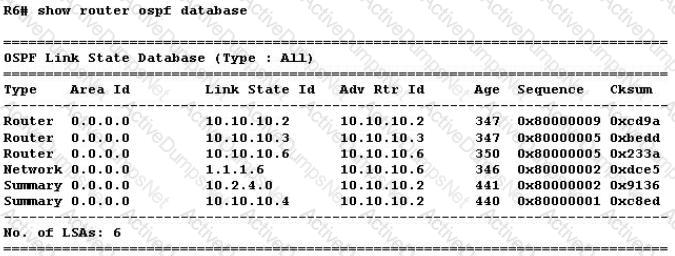
Given the output shown, which router is the ASBR in this network?
Click on the exhibit button below.
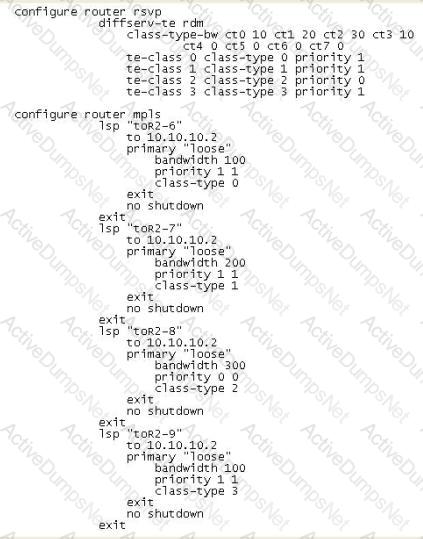
If the four LSPs shown use the shared-explicit reservation style, how much bandwidth does CSPF request across a single 1Gbps link?
Click on the exhibit.
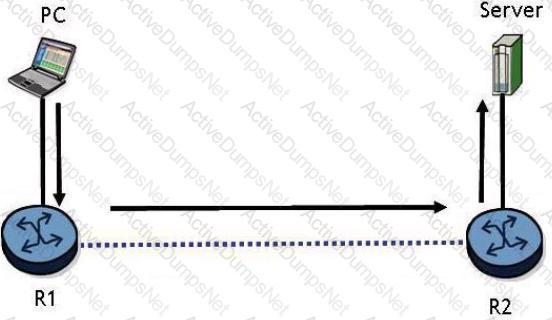
Which of the following best describes the format of data traffic sent to the server as it exits from the PC?
Which is the OSPFv3 equivalent to the OSPFv2 Type 7 LSA?
Click on the exhibit.
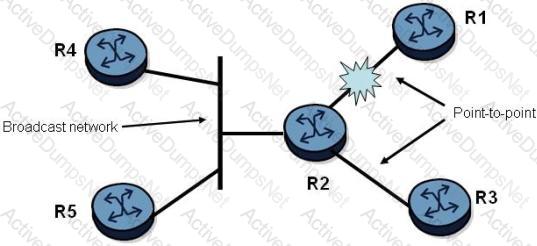
OSPF router R2 has both point-to-point and broadcast interfaces and it is not a DR for any interfaces. Router R2 detects the link failure between itself and router R1.
Which of the following is correct?
An OSPF backbone area contains Type 5 LSAs. If an attached area receives only Summary LSAs from the backbone area, what type of area is the attached area?
Why does IPv6 not use ARP?
Which of the following is FALSE about the databases used by a link-state routing protocol in a single area routing domain?
Click on the exhibit.
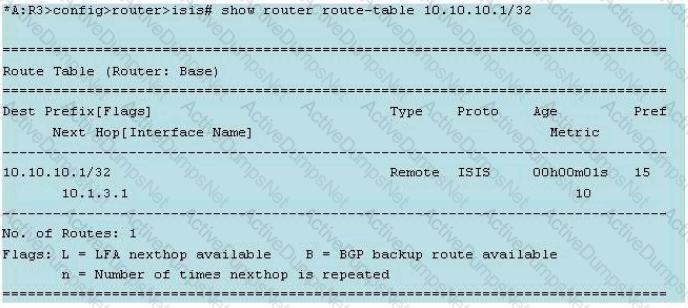
The operator of an IS-IS network wishes to have link metrics dynamically calculated in the same manner as OSPF. The router with system address 10.10.10.1 is one hop away on a 1 Gbps link
Which of the following is correct?
Click on the exhibit.

Router R2 uses IS-IS to advertise the network 192.168.3.0/24 to R1. How can router R1 discard the route?
Which of the following statements regarding LDP-over-RSVP are true? (Choose two)
Which of the following are characteristics of an LSP? (Choose two)
Click on the exhibit button below.
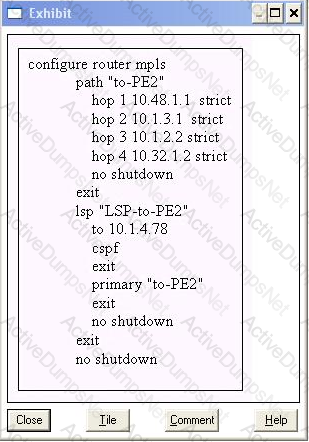
Given the configuration below, which of the following commands would enable fast reroute on the LSP? Choose two answers
Click on the exhibit.
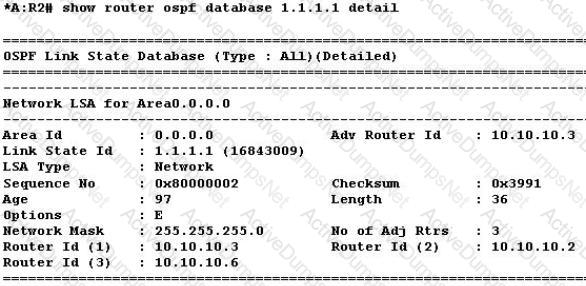
Which router is the designated router for the broadcast network?
Click on the exhibit.
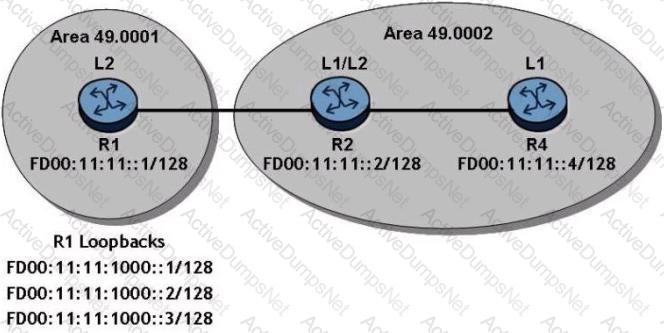
Router R1 distributes its loopbacks into IS-IS and globally routed addresses are configured as shown.
How many routes will router R4 have in its IPv6 route table?
What event causes an OSPF adjacency to change from 'down' to 'two way'?
Which of the following statements regarding RSVP-TE is FALSE?
Click on the exhibit button below.
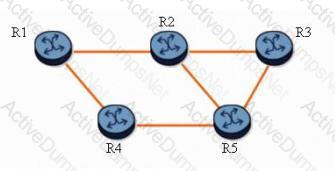
With fast reroute enabled, and given the following:
- Two protected LSPs with the path R1-R2-R3
- Both LSPs enable facility bypass and link protection.
When router R1 is the PLR, which router becomes the MP?
Click on the exhibit.
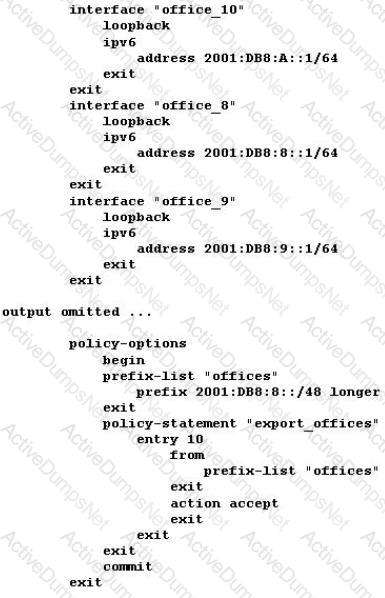
An OSPFv3 router is attached to a non-OSPF domain that includes networks 2001:DB8:8::/64.2001 .DB8:9::/64 and 2001 :DB8:A::/64. Other routers in the OSPF domain see the prefix 2001, DB8:8::/64, but not the other two prefixes.
What could cause this?
Which of the following LDP messages are used in the successful establishment of LDP sessions? Choose three answers
Click on the exhibit.
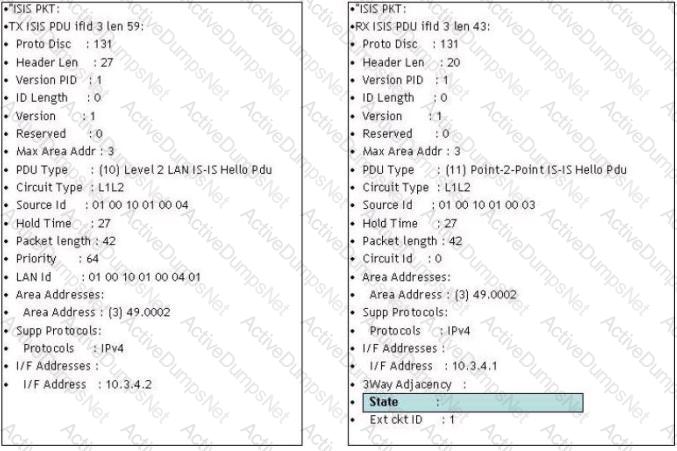
What value would be expected in the state field?
Which of the following is not included in a Router LSA?
Click on the exhibit.
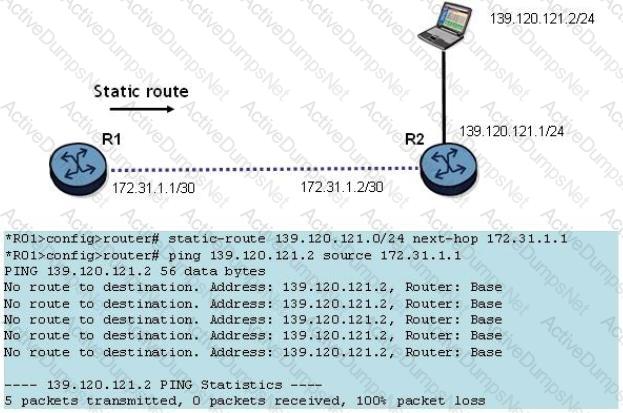
A static route has been configured on router R1 to reach the PC at 139.120.121.2. What might be causing the ping to fail?
Click on the exhibit.
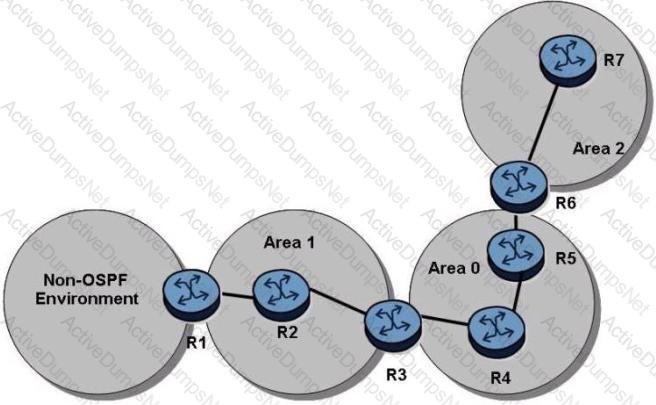
In the topology shown, router R1 is an ASBR configured to export external routes to OSPF. There are no stub or NSSA areas. Which of the following regarding LSAs is TRUE?
Which part of the NSAP address is used to indicate to the end system that a packet is to be processed by the router itself?
Click on the exhibit.
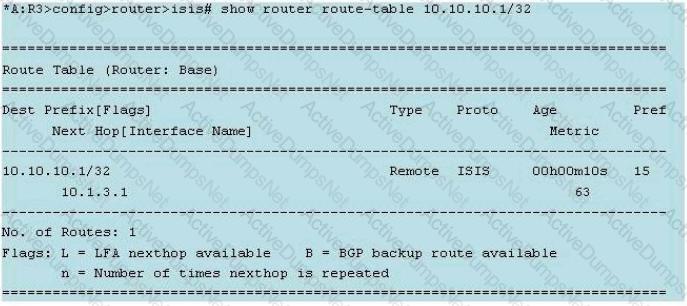
The operator of an IS-IS network wishes to have link metrics dynamically calculated in the same manner as OSPF. The router with system address 10.10.10.1 is one hop away on a 1Gbps link
Which of the following is correct?
Facility fast reroute with node protection is enabled for an LSP, which of the following is FALSE?
Port 1/1/1 has been configured as an access port with encapsulation dot1q on an Alcatel-Lucent 7750 SR. Which of the following statements are TRUE? (Choose 2)
Click on the exhibit button below.

Is a routing policy required on PE1 to advertise a CE1's system interface to PE2?
Click on the exhibit.
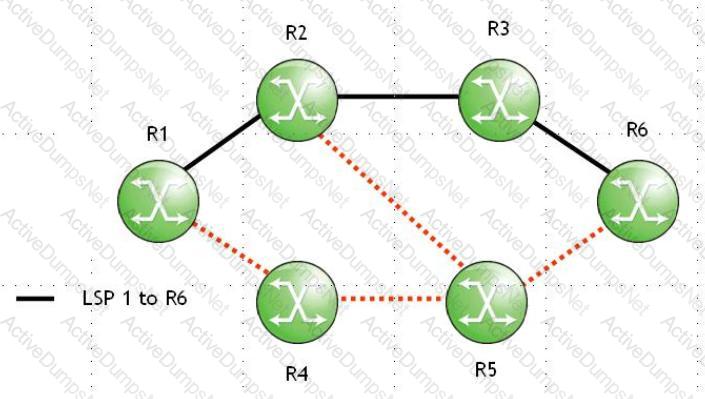
RSVP state for LSP 1 has timed out on router R3. Which of the following actions will router R3 initiate to clear the RSVP session?
Which of the following statements are TRUE about configuring a distributed Epipe service? (Choose 2)
What is a key benefit of a VPLS service?
What does a PE do when a frame is received in a VPLS service with an unknown destination address by default?
Which of the following statements is TRUE concerning route distinguishes on the 7750 SR?
Click on the exhibit.
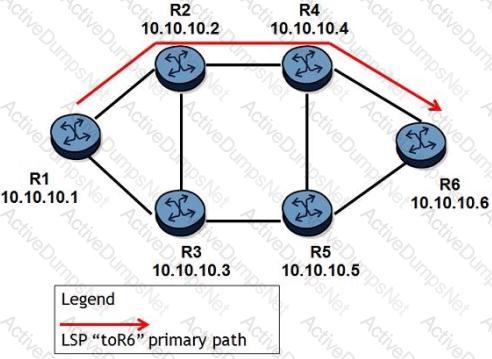
An LSP traverses R1-R2-R4-R6 and one-to-one fast reroute with link protection is enabled. All links have the same cost. Which of the following about DMP and MP is TRUE?
A technician sitting in a Network Operations Center would like to set up a remote mirror on an Alcatel-Lucent 7750 Service Router to examine some data traffic ingressing a port at a remote site. Which of the following are required? (Choose 2)
Which of the following best describes a VPRN?
In a VPLS service, the mesh-sdp vc-id is identical to the service id by default.
What are the default settings for RSVP-TE on the Alcatel-Lucent 7750 SR?
Which mode does the following statement describe? An LSR will advertise a label mapping immediately, without waiting for a label mapping from the FEC's next-hop.
Fill in the blanks: A ________device has all interfaces inside the provider domain, and a _______ device has at least one interface outside the provider domain.
Click on the exhibit.
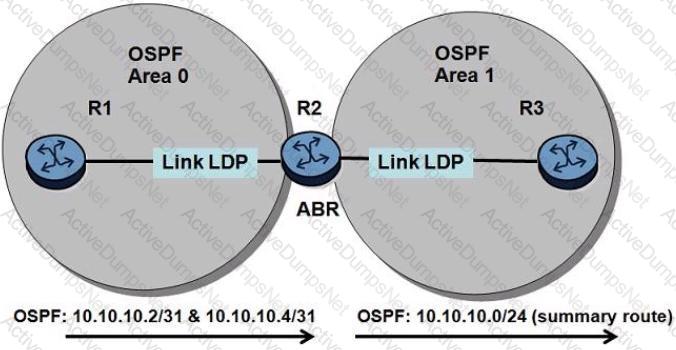
Router R2 advertises the aggregate prefix 10.10.10.0/24 into Area 1. Why would LDP aggregate-prefix-match be enabled on router R3?
What action does a router perform when it looks up the label of an incoming packet in its LFIB and sees that the LFIB maps to an egress label of 3?
3 Epipe services and 2 VPLS services have been configured between two PE routers. How many service labels will be signaled in total?
Click on the exhibit.
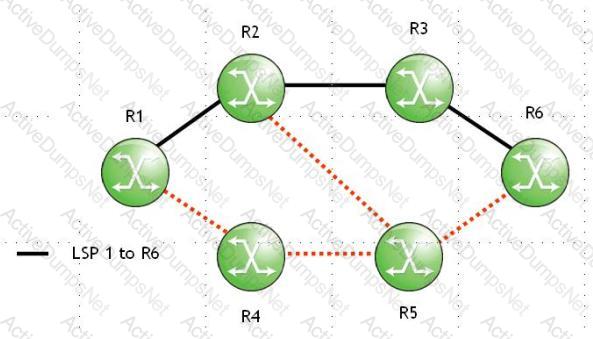
LSP 1's link between routers R3 and R6 has failed, and the RESV state at router R3 has timed out. Which of the following actions will router R3 initiate?
Which MPLS label mode propagates a label mapping only for the FEC for which a router has a label mapping for the FEC's next-hop?
Click on the exhibit.
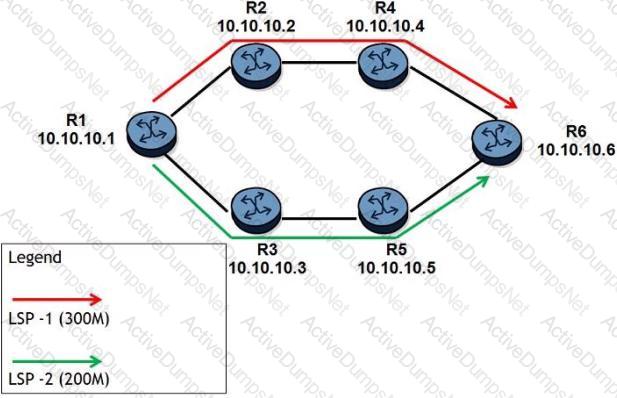
All links have 1 Gbps unreserved bandwidth initially and all LSPs have the least-fill feature enabled. After the two LSPs have been signaled as shown, two additional LSPs are configured.
LSP-3 is signaled first with 50Mbps reserved. LSP-4 is signaled after with 400Mbps reserved.
Which paths will CSPF choose for LSP-3 and LSP-4?
Click on the exhibit.
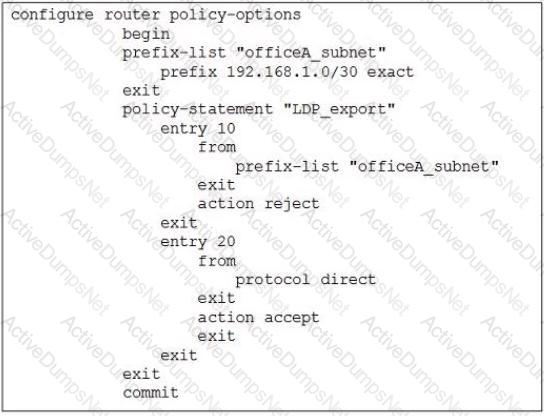
This policy is applied as an LDP export policy. In addition to the FECs learned from its neighbors, which FECs will appear in this router's LIB?
Which LSA type is used for OSPF-TE?
Click on the exhibit.
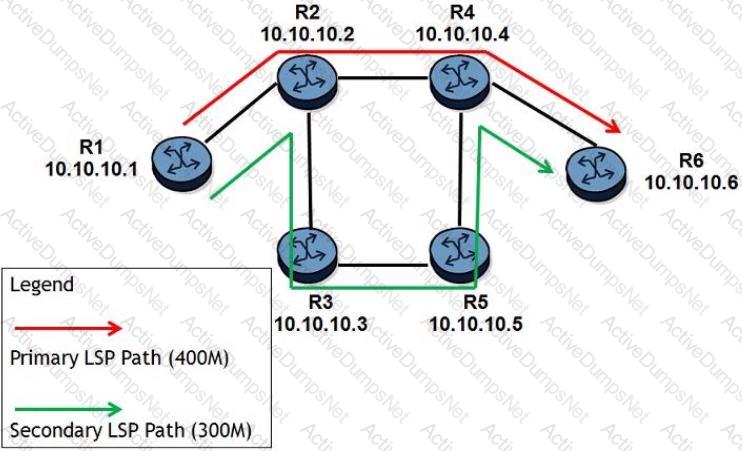
All links have 1Gbps unreserved bandwidth initially and Shared Explicit reservation style is used. After the LSP's primary and standby secondary paths are signaled, how much unreserved bandwidth is left on the links?
Customer 'A' has sites on 3 different Alcatel-Lucent PE routers. The routers are connected to each other through an IP/MPLS network in a full mesh fashion. Customer 'A' requires a VPLS service. Which of the following statements are TRUE? (Choose2)
Using facility mode fast reroute, how does the PLR learn the address of the MP?
Which mode does the following statement describe? An LSR will advertise a label mapping immediately, without waiting for a label mapping from the FEC's next-hop.
If an LSP needs to use an admin group, which of the following configurations is NOT required on the Alcatel-Lucent 7750 SR?
Click on the exhibit.
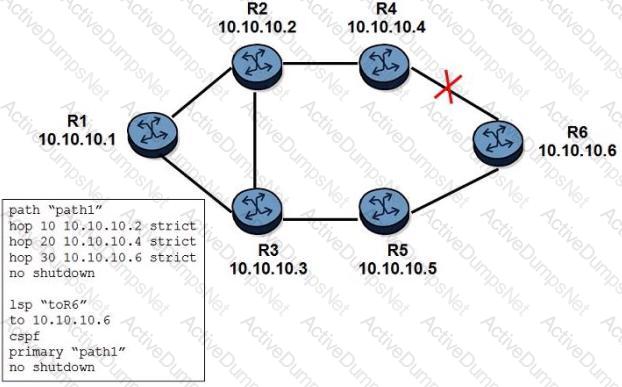
The link between routers R4 and R6 is down before the LSP is signaled. CSPF is enabled on the LSP. Which of the following conditions is TRUE?
Click on the exhibit. After the Isp-ping command is executed, which of the following best describe the router's action?
Which of the following steps is mandatory when enabling an MP-BGP session between PE routers in a VPRN?
Which of the following describes 6PE?
Click the exhibit button.
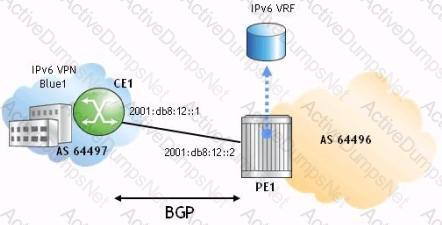
Part of a 6VPE deployment is shown. Which of the following is the correct configuration and context on router CE1 for a BGP peering session with 6VPE1?
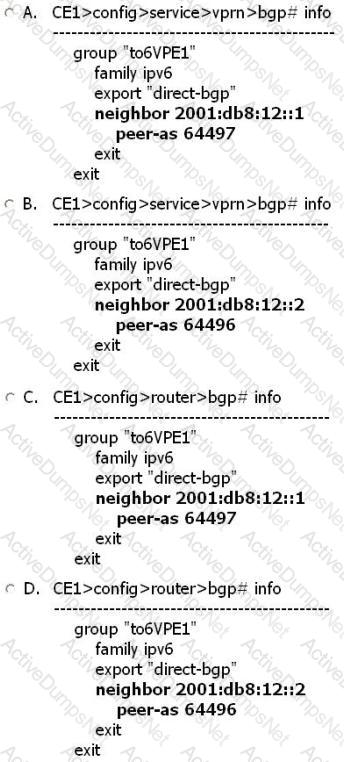
Which of the following about configuring a distributed E-pipe service is TRUE?
By default, what does an Alcatel-Lucent 7750 SR do to support VPLS services for different customers?
Which of the following SAPs will NOT forward untagged frames?
The SAP 1/1/1:2.3 receives an untagged Ethernet frame. Which of the following is TRUE?
Which of the following statements about SAPs that are part of a VPVVS is FALSE?
Which of the following about IES is FALSE?
What command syntax would be used to create a new routed interface on an existing IES service?
Click the exhibit.
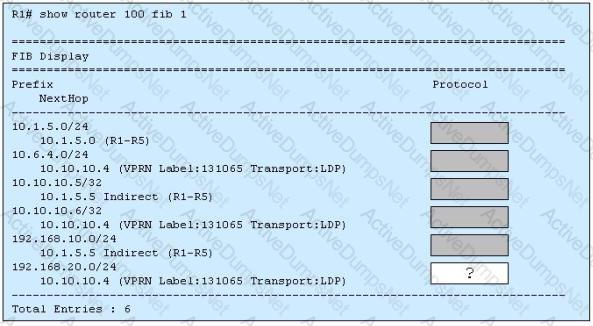
The output is from PE router R1 about VPRN service 100. From which protocol did router R1 learn the prefix 192.168.20.0/24?
Click the exhibit.
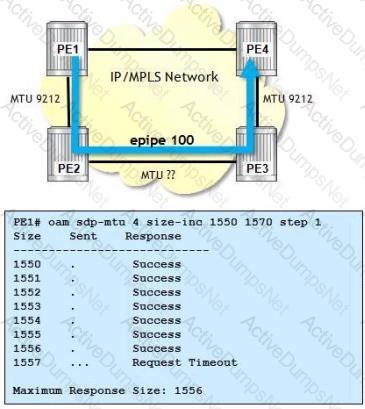
E-pipe 100 is using an SDP with an LSP that uses the path shown (PE1-PE2-PE3-PE4). Based on the OAM command output, which of the following is FALSE?
Click the exhibit.
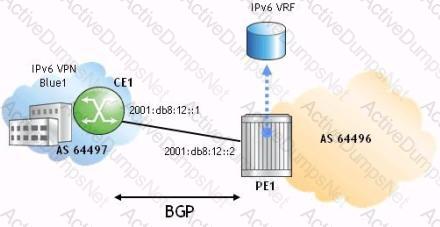
Part of a 6VPE deployment is shown in this exhibit. Which of the following is the correct configuration and context on PE1 for a BGP peering session with CE1?
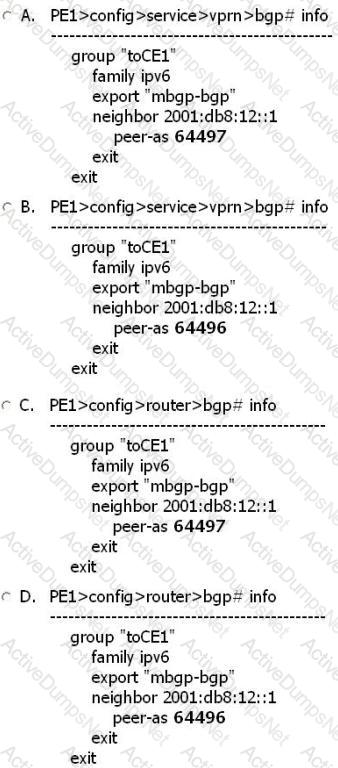
Which of the following statements about VPRN is NOT true? (Choose 2)
By default, what does the Alcatel-Lucent 7750 SR do when a frame with an unknown destination address is received in a VPLS?
Click the exhibit.
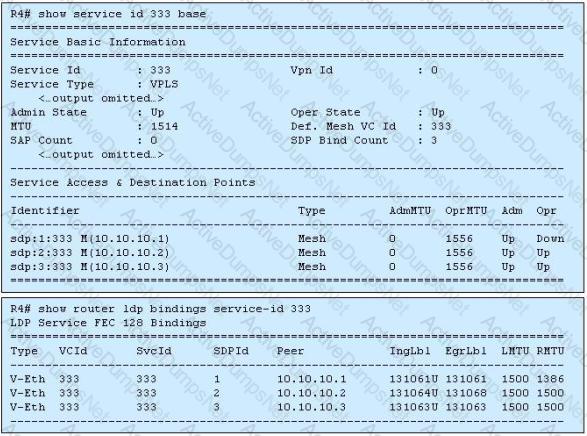
Both clips of output are from router R4. The show service command indicates that an SDP is down. What might be the cause?
In a Layer 2 VPN service, the FCS is stripped when a customer packet arrives at the ingress PE and regenerated on egress.
Which of the following statements are FALSE regarding the VPN-IPv4 address family? (Choose 2)
On an Alcatel-Lucent 7750 SR, which vc-type will forward service delimiting tags at the ingress PE?
Which of the following about VPLS MAC learning is TRUE?
Which of the following SAP encapsulations support multiple services on a port? (Choose 3)
Which of the following commands can be used to compare the VC MTU signaled between two PE routers?
Which of the following about VPRN route targets is FALSE?
In a Layer 2 encapsulation using T-LDP, what does the first (top) label represent?
Which of the following best describes the flooding of traffic on a PE when unknown traffic is received on a SAP of a VPLS?
Click the exhibit.
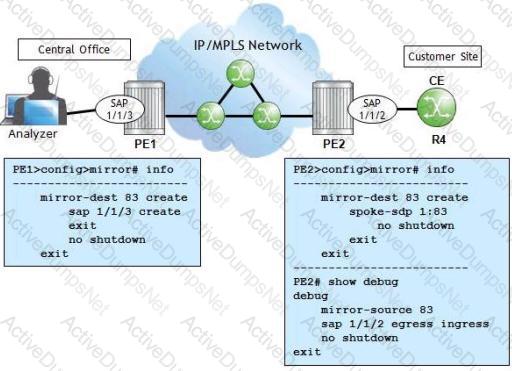
PE1 and PE2 are Alcatel-Lucent 7750 SRs. What needs to be added to PE1's configuration to mirror traffic between PE2 and the customer site?
Click the exhibit.
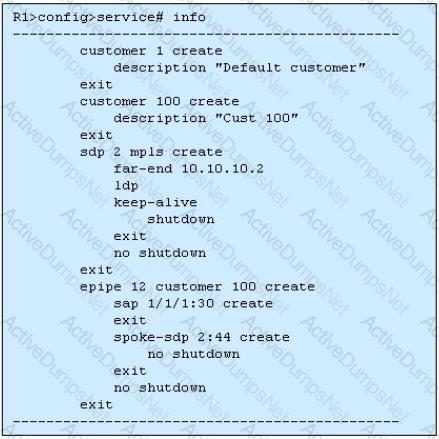
Based on the output shown, what is the value of the service's VC ID?
A SAP configured in the form of 1/1/1:0/32 would be used for which type of VPWS?
Click the exhibit.

Which OAM tool produced this output?
Which of the following about transport and service tunnels is FALSE?
Which of the following statements best describes the main difference between an Ipipe and an Epipe interworking?
Which of the following about route distinguishes on the Alcatel-Lucent 7750 SR is FALSE?
Click the exhibit. This output is from router R4. Service 333 is a VPLS. Why might the peer 10.10.10.1 have the same value for IngLbl and EgrLbl?
On an Alcatel-Lucent 7750 SR, the OAM command 'svc-ping' can be used with options bcal-sdp' and 'remote-sdp'. Which of the following is TRUE?
What is the default preference value for a static route in the Alcatel-Lucent 7750 SR?
Which one of the following is a valid IPv6 multicast address?
Click the exhibit button.
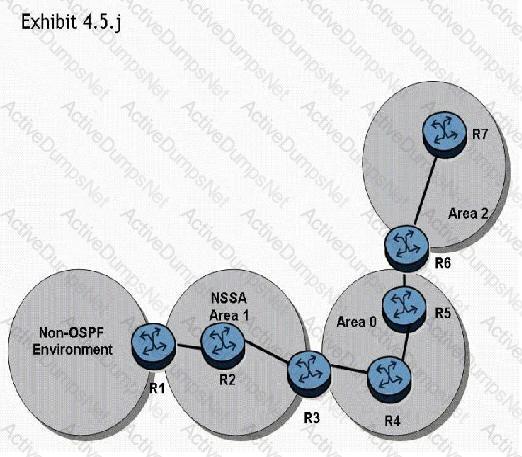
In the topology shown, router R1 is an ASBR configured to export external routes to OSPF. Which of the following statements regarding the OSPF LSAs in the network is true?
Which of the following describes the method used to resolve an IPv6 address to a MAC address?
Which of the following best describes how IS-IS routers exchange updates on an Ethernet interface?
What command will show the IS-IS neighbors, and their status on an Alcatel-Lucent 7750 SR?
What type of OSPF router generates a type 2 LSA?
How are IS-IS LSPs sent on point-to-point links?
Exhibit
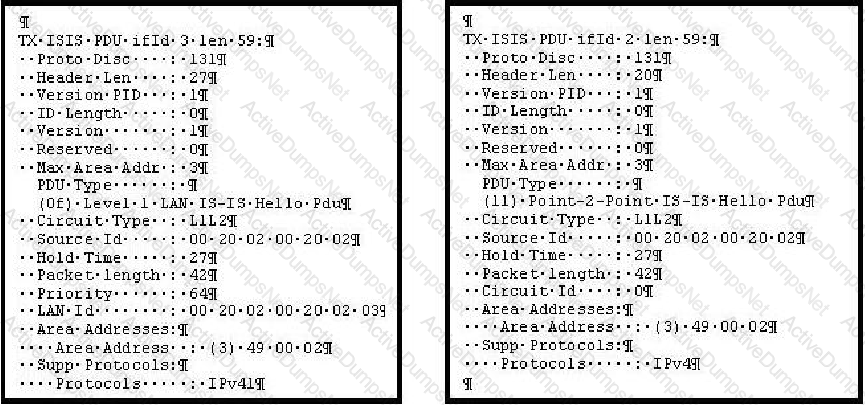
The following IS-IS packets have been exchanged between 2 adjacent IS-IS routers. What type of adjacency will be formed?
From the list below select the statements that describe the behavior of link state information aging. (Choose 2)
Click the exhibit button.
Which of the following statements best describes the format of data traffic sent from the PC to the server?
Click the exhibit button.
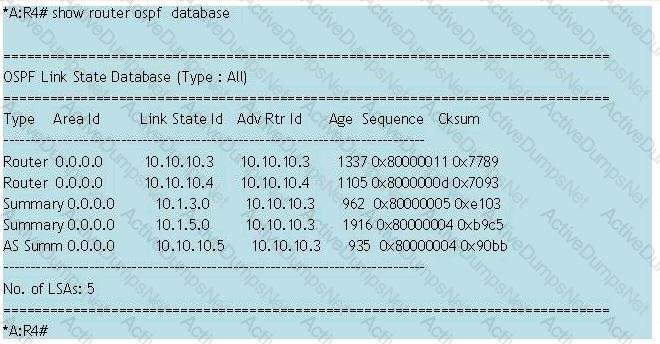
Assuming that the router ID of the router shown is 10.10.10.4, which of the following statements regarding the CLI output is true?
What are the three databases maintained by a Link State Protocol?
Click the exhibit button.
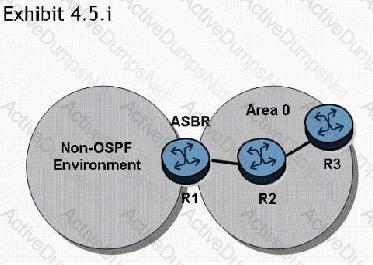
In the topology shown, router R1 is an ASBR configured to export external routes to OSPF. How many type 4 LSAs will be present in the network?
What modes of authentication are supported for RIPv2 on the Alcatel-Lucent 7750 SR?
What is the term used for the updates sent by IS-IS?
Which three IS-IS PDU types are used for database synchronization?
Refer to the exhibit below.
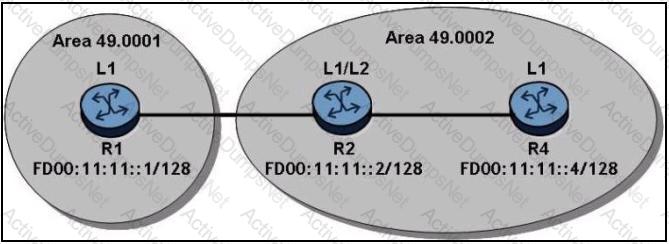
R1 distributes its loopbacks into IS-IS and globally routed addresses are configured as shown. How many routes will R4 have in its IPv6 route table?
Click the exhibit button.
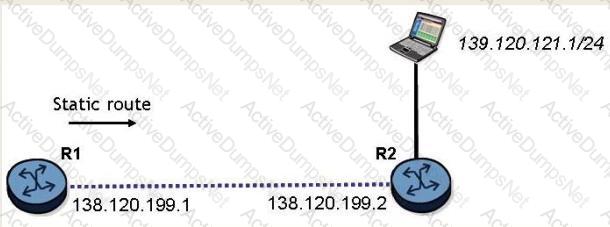
What is the command to configure a static route on the 7750 service router R1 to reach the network behind router R2?
In an OSPF Hello packet, which of the following fields must match for all neighbor routers on the segment? Choose three answers.
Click the exhibit button.
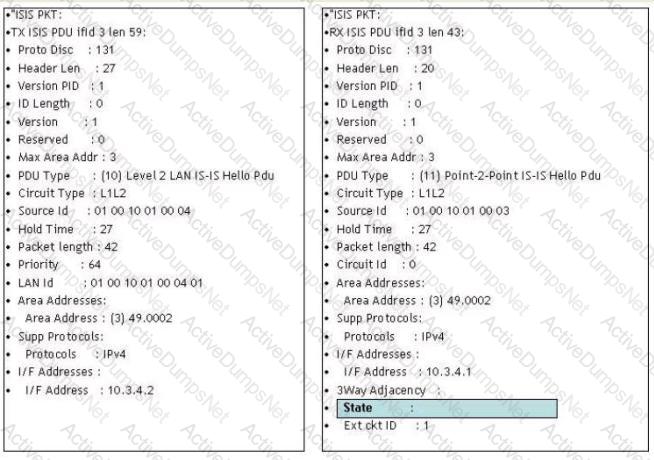
What is the state of adjacency?
What are some of the characteristics of Alcatel-Lucent's implementation of non-stop routing? (Choose two)
Which of the following statements best describes an OSPF type 3 LSA?
Graceful Restart is supported by what IGPs?
What is the protocol number for OSPF in the IP header?
From the list below identify two matching criteria supported for IP filters on the Alcatel-Lucent 7750 SR: (Choose two)
At what point is the LSP SRM flag cleared when an LSP is sent on an IS-IS point-to-point link?
Choose two answers.
What is the value of the protocol discriminator used to denote IS-IS protocol information?
In an OSPF Hello packet what fields must match all neighbor routers on the segment? (Choose 3)
Which of the following types of networks are supported on an Alcatel-Lucent 7750 SR for OSPF? Choose two answers.
Which of the following commands can be used to display the number of SPF computations that have been performed on a router?
